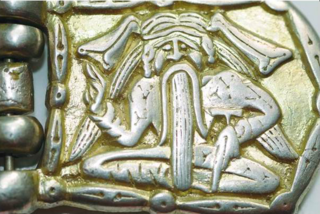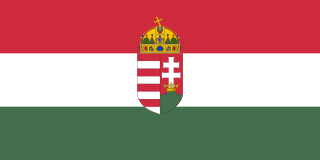Related Research Articles
In grammar, the accusative case of a noun is the grammatical case used to receive the direct object of a transitive verb.
In linguistics, declension is the changing of the form of a word, generally to express its syntactic function in the sentence, by way of some inflection. Declensions may apply to nouns, pronouns, adjectives, adverbs, and determiners to indicate number, case, gender, and a number of other grammatical categories. Meanwhile, the inflectional change of verbs is called conjugation.

Hungarian is a Uralic language spoken in Hungary and parts of several neighbouring countries that used to belong to it. It is the official language of Hungary and one of the 24 official languages of the European Union. Outside Hungary, it is also spoken by Hungarian communities in southern Slovakia, western Ukraine (Subcarpathia), central and western Romania (Transylvania), northern Serbia (Vojvodina), northern Croatia, northeastern Slovenia (Prekmurje), and eastern Austria.

The Ugric or Ugrian languages are a proposed branch of the Uralic language family.
Hungarian grammar is the grammar of Hungarian, a Finno-Ugric language that is spoken mainly in Hungary and in parts of its seven neighboring countries.
This page is about noun phrases in Hungarian grammar.
Hungarian orthography consists of rules defining the standard written form of the Hungarian language. It includes the spelling of lexical words, proper nouns and foreign words (loanwords) in themselves, with suffixes, and in compounds, as well as the hyphenation of words, punctuation, abbreviations, collation, and other information.

Hungarian shamanism is discovered through comparative methods in ethnology, designed to analyse and search ethnographic data of Hungarian folktales, songs, language, comparative cultures, and historical sources.

Béla of Macsó was a member of the Olgovichi clan. He was Duke of Macsó (1262–1272) and of Bosnia (1266/1271–1272); and thus he governed the southern provinces of the Kingdom of Hungary.
Imre Dimény was a Hungarian agrarian engineer and Communist politician, who served as Minister of Agriculture and Food between 1967 and 1975. He was a member of the Hungarian Academy of Sciences.
Gábor Vékony was a Hungarian historian, archaeologist and linguist, associate professor at Faculty of Humanities of the Eötvös Loránd University, Candidate of Sciences in History. He was an expert of the rovás scripts and a researcher of Hungarian prehistory.

The Hungarian Republic was a short-lived republic that existed between August 1919 and February 1920 in the central and western portions of the former First Hungarian Republic. The state was established in the aftermath of the Hungarian–Romanian War by counter-revolutionary forces who sought to return to the status quo prior to 31 October 1918.
Thomas (I) Szécsényi was a Hungarian powerful baron and soldier, who rose to prominence during King Charles I's war against the oligarchs. He belonged to the so-called "new aristocracy", who supported the king's efforts to restore royal power in the first decades of the 14th century. He was the first member of the influential Szécsényi family.

The Dömös Chapter was a collegiate chapter, established around 1107, in the Kingdom of Hungary. It was dedicated to Saint Margaret of Antioch.
The Titel Chapter was a collegiate chapter, established in the late 11th century, in the Kingdom of Hungary. It was dedicated to the Holy Wisdom.

A sárkány ("dragon") is a legendary monster found in Hungarian mythology. It usually appears as a scaly, winged, reptilian beast, but in some cases it could be a mixture of other beings.

The Kolozsmonostor Abbey was a Benedictine Christian monastery at Kolozsmonostor in Transylvania in the medieval Kingdom of Hungary. According to modern scholars' consensus, the monastery was established by Ladislaus I of Hungary before 1095.
Vata or Vatha was a Hungarian noble, lord of the castle of Békés and chief of a tribe in Körösvidék. He is known for being the leader of the Vata pagan uprising.

Dávid Baróti Szabó was a Hungarian Jesuit priest, poet, writer and linguist.
References
- 1 2 Referred to as formativus by É. Kiss, Katalin (profile) –Kiefer, Ferenc (cv) –Siptár, Péter.Új magyar nyelvtan. ISBN 963-389-521-9, p. 202 (204 in the online PDF)
- 1 2 Referred to as formativus by Kiefer, Ferenc (cv) : 3.9.3. Az esetragok (‘Case Suffixes’). In: Kiefer, Ferenc (ed.), Magyar nyelv ‘Hungarian Language’. Akadémiai Kiadó. Online publication: 2015. Print publication: 2006. ISBN 978 963 058 324 4
- 1 2 Referred to as formativus by Kiefer, Ferenc: A ragozás (‘Suffixation’ or ‘Inflection’ or ‘Conjugation and Declension’), 10.3.1. Az esetragok (‘Case Suffixes’). In: Kiefer, Ferenc (ed.). Strukturális magyar nyelvtan (‘Structural Grammar of Hungarian’) Vol. 3. Morfológia (‘Morphology’). Akadémiai Kiadó. Online publication: 2018. ISBN 978 963 454 053 3
- ↑ Referred to as essivus, the same term as the one for the suffix of the essive-modal case, ending in -ul/ül, though listed as a distinct item. Balogh, Judit. A névszóragozás (‘Declension’). In: Balogh et al., Magyar grammatika (‘Hungarian Grammar’), Műszaki Könyvkiadó, Piliscsév & Budapest, 2017 ( ISBN 978 963 164 694 8), pp. 197 and 201.